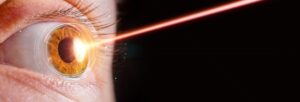If you found out that you are not a Lasik candidate and you no longer wish to wear glasses or contact lenses, there are a variety of different procedures that one can look into to improve your vision. Here are two prospective options that are highly recommended depending on your individual needs.
Photorefractive Keratectomy (PRK)
Over the past 20 years, PRK’s results have stood the test of time for long term stability. You keep more corneal tissue than with LASIK, ensuring the integrity of your eyes over time. With more corneal tissue, you are also better able to have a “touch up” procedure if necessary. In most cases, PRK is recommended for patients who have thinner corneas, slightly irregular corneas, or are at risk for dry eyes or other conditions. Your doctor will be able to make a recommendation for you based on extensive testing.
In other cases, patients who are candidates for LASIK chose to have PRK instead, because they prefer a flapless or bladeless procedure. PRK is a specialty procedure, meant to address the needs of people with unusual eye measurements. This procedure still uses a laser to help with vision correction, but instead of going under the surface of the eye like LASIK, this procedure is performed directly on the surface of the eye. PRK, is a very quick and efficient alternative to LASIK taking about five minutes per eye and is performed using a topical anesthesia. A brush or alcohol and mitomycin C (MMC) is used to prep the treatment area. MMC has been shown to reduce the risk of corneal haze/scarring in many studies while having a good track record of minimal adverse effects.
Unlike LASIK, you run minimal risk of flap-related complications and dry eyes, because there is no disruption in the nerves that tell your eyes to produce tears. Recovery time after a PRK procedure takes about 2 – 3 days in order to allow for your eyes to fully correct. Once the eye is corrected, the surgeon will place a soft contact lens to protect your eye while the healing takes place. During the healing time – 5 to 7 days – it is normal to experience blurry or fluctuating vision, light sensitivity and/or dryness. It is common for one eye to heal faster than the other. You will be given oral pain medication if necessary, along with topical eye drops. You may find that you do not feel confident driving while the protective lenses are in.
Your soft contact lenses will be removed after your one week follow-up visit and you will notice your vision will slowly improve. Drops will be given to use for several weeks, which will aid in healing and prevention of inflammation. Although it can take a few weeks to a few months for patients to fully reach their optimal vision, your visual outcome will be the same as if you had LASIK. However, the long-term safety and stability of your eyes will be higher than if you had the LASIK procedure. A few days or weeks of patience will be rewarded by a lifetime of better vision.
Implantable Contact Lens (ICL)
For Years, the only method of permanent vision correction that didn’t involve contact lenses, glasses, or the removal of a cataract was corrective laser eye surgery. Now near-sided patients who might not have been a candidate for LASIK have a viable alternative to glasses and contacts. You can enjoy vision that is clearer and more vivid in a simple outpatient procedure that doesn’t remove any corneal tissue. This lens is flexible with built-in protection against harmful UV light rays. Candidates for the ICL are between 21 and 45 years of age, suffer from myopia (nearsightedness), and want to experience superior vision correction.
The ideal ICL candidate has not undergone any ophthalmic surgery and does not have a history of eye disease such as iritis, glaucoma, or diabetic retinopathy. A surgeon will insert the ICL through a small micro-opening, placing it inside the eye just behind the iris in front of the eye’s natural lens. The ICL is designed to stay in position with no special care. It is designed to be completely unobtrusive after it is put in place. It stays in position by itself and does not interact with any of the eye’s structures. After the simple 15-minute outpatient procedure, patients experience an immediate improvement in vision quality and are “Wowed” by the results.
There is a small risk of increased intra-ocular pressure for which patients will be closely monitored during the first 24 hours after the procedure. The risk of an extensive course of inflammation is very low. Eye rubbing or having ICL lens positioned too close one’s native lens may increase the risk of cataract formation long term.
For any eye procedure is it suggested that you see a recommended eye care provider like the team at Diamond Vision. They will evaluate and recommend the best procedure for you while assisting with any post care needs. Diamond Vision in NYC is focused on keeping clients informed in all areas of eye health while providing a variety of vision corrective procedures.
Source: www.DiamondVision.com
Contact Us
If you have more questions about LASIK procedures, get in touch with us.
Related Blogs

Who Should Not Have Laser Eye Surgery
Laser eye surgery, commonly known as LASIK (Laser-Assisted In Situ Keratomileusis), has revolutionized the world of vision correction. It’s a procedure that has enabled millions

LASIK eye surgery: What is LASIK and how does it work?
What Is LASIK? Experts categorize LASIK as a refractive eye surgery in which lasers are used to correct vision problems. LASIK corrects several refractive errors,

Everything You Need To Know About The Lipiflow Treatment
LipiFlow is often referred to as a ground-breaking technology that is able to treat dry eye issues caused by meibomian gland dysfunction, or MGD. Experts
